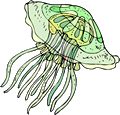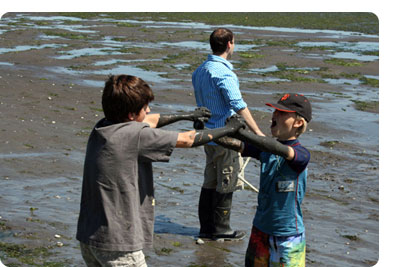 The Nature Center offers a variety of environmental education activities available to public and private schools, home schools, and  other educational groups. Our activities primarily focus on marine and estuarine ecosystems as well as some broader environmental concepts such as food webs and adaptaion. other educational groups. Our activities primarily focus on marine and estuarine ecosystems as well as some broader environmental concepts such as food webs and adaptaion.
Educational activities are available to all age groups, including preschool and up. NRNC educators are fantastic at fine-tuning activities to match your specific subject needs.
Below is a list of hands-on programs currently available for group sessions, or just click here to read descriptions of all the programs. Each program is designed to last 20 - 30 minutes but can be altered to fit your needs. If you are interested in scheduling a class, please download the Education Visit Application and return it to the Nature Center, or contact the Nature Center at (360) 459-0387. We will be happy to give you more information and send you an application. Typically, classes are $30 for up to 30 students. Add $1 for each additional student.

Summer Camp
We also offer a day camp program during the summer. Check it out!
Educational activities are available to all age groups, preschool and up. NRNC educators are fantastic at fine-tuning activities to match your specific subject needs.
Amazing Wetland Animals
(Kindergarten - 2nd grade)
An introduction to some of the animals commonly found in an estuary, and the adaptations that help them survive.
No backbone? No problem!
(2nd - 4th grade)
Get to know the estuary's invertebrate community. Find out where they live, what they eat, how they grow, and why they're important.
Homing Instincts for Salmon
(3rd - 5th grade)
This activity illustrates how salmon in the ocean always find their way back to the same river they were born in.
Web of Life
(4th - 7th grade)
This exercise helps students to see the inter-relationships between the living organisms and the physical structures of the beach.
It Came from the Intertidal Zone
Low Tide Required
(4th grade and up)
In this fun activity, students learn to distinguish the five intertidal zones of a beach. By digging in the mud, everyone gets to meet the critters that live in each zone personally.
Micro Odyssey
(4th grade and up)
What is plankton? Students unravel the mystery of plankton by observing them through microscopes and participating in discussions that introduce their characteristics and importance.
Wetland Metaphors
(4th grade and up)
The importance of wetlands is demonstrated in this exercise where students learn the fundamental functions of the wetland ecosystem.
Be an Estuary Ecologist
(5th - 8th grades)
Ever wonder how far underwater plants can grow? How do you measure salinity? What do barnacles look like before they attach to pilings? Discover the answers to these questions and more by being an "estuary biologist."
Beach Walk (Low Tide Suggested)
(All ages)
Take a natural history walk along the Luhr Beach shoreline and observe the plant and animal life that lives at Nisqually Reach. Learn how everything in an estuary is linked together. A leave-in-place scavenger hunt is available for this program.
|





|





